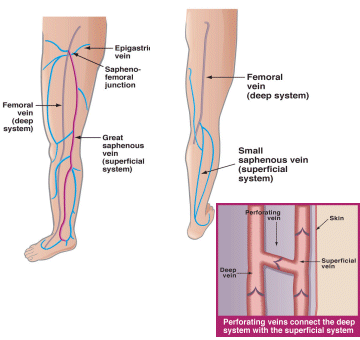|
| | |
The Venous System Anatomy
The venous system is made up of a network of veins, including:
- Superficial veins
- Deep veins
Perforator veins connect the deep and superficial venous systems.
The Closure procedure treats venous reflux disease in the superficial venous system, often
the underlying cause of painful varicose veins.

|
|
| |
Understanding Venous Reflux Disease

Healthy leg veins contain valves that open and close to assist the return of blood
back to the heart. Venous reflux disease develops when the valves that keep
blood flowing out of the legs and back to the heart become damaged or diseased. As
a result, vein valves will not close properly leading to symptoms of:
- Varicose veins
- Pain
- Swollen limbs
| |
- Leg heaviness and fatigue
- Skin changes and skin ulcers
|
Superficial venous reflux disease is progressive--symptoms will worsen over
time if left untreated.

Are You a Candidate?
Many factors contribute to the presence of venous reflux disease, including:
- Age
- Gender
- Family History
| |
- Multiple pregnancies
- Obesity
- Standing profession
|
Using ultrasound to scan your legs, we can determine if
superficial venous reflux is present.
|
|
| |
Experience the Closure Procedure
The Closure procedure is performed on an outpatient basis. Using ultrasound,
your physician will position the Closure Catheter into the diseased vein, through a small
opening in the skin. The tiny catheter delivers radiofrequency (RF) energy to the vein wall. As the RF energy is delivered and the catheter is withdrawn, the vein
wall is heated causing the collagen in the wall to shrink and the vein to close. Once
the diseased vein is closed, blood is re-routed to other healthy veins.

"The procedure was quick and nearly pain free. I was active following the Closure
procedure and noticed immediate relief of symptoms. For me, the Closure procedure
was a success!" - Mary C.
Following the procedure, a simple bandage is placed over the
insertion site, and additional compression may
be provided to aid healing. Your doctor may encourage you to walk, and to
refrain from extended standing and strenuos activities for a period of time.
Patients who undergo the Closure procedure typically resume normal activities
within a day.
|
|
| |
A Treatment That Works
In a comparative trial versus vein stripping surgery, results were in favor of the
Closure Procedure. Findings indicated that patients who underwent the Closure procedure:
- Experienced less post-operative pain and bruising
- Resumed normal activities within one day
- Returned to work more than a week earlier than vein stripping patients
At two years following treatment, patients who had undergone the Closure procedure
reported superior quality of life compared to vein stripping patients.
The Closure procedure has proven to be highly effective, with
higher that 90% of veins treated remaining reflux-free at two years. Results also
demonstrate long-term relief of symptoms:

|
|
| |
Visual Results
The Closure procedure results in good cosmetic outcome with
minimal to no scarring, bruising or swelling.

"The cosmetic appearance of my legs has improved significantly. The
bulging veins are no longer present. Now, I look forward to wearing
skirts and showing off my legs during the summer months." - Sandra C.
| | |
Frequently Asked Questions
Q: Is the Closure procedure painful?
A: Patients report feeling little, if any pain during and after the procedure.
Q: How quickly can I resume normal activity?
A: Patients are walking immediately following the procedure, and patients typically
resume normal activites within one day.
Q: How soon will my symptoms improve?
A: Many patients notice an immediate relief of symptoms such as pain, leg heaviness and
fatigue. The full benefits of the procedure may take 1-2 weeks.
Q: Is there any scarring, bruising, or swelling after the procedure?
A: Patients report minimal to no scarring, bruising, or swelling following the procedure.
Q: How is the Closure procedure different from vein stripping?
A: During vein stripping, incisions are made in the groin and calf, and a stripper
tool is threaded through the diseased vein to pull the vein out of the leg. With the
Closure procedure, only one small puncture is made at the
insertion site and the vein is the closed and left in place. This minimally invasive approach eliminates
pain, swelling, and bruising associated with vein stripping surgery.
Q: What if I need the vein for bypass surgery in the future?
A: The Closure procedure treats diseased veins only, which are not appropriate for bypass surgery.
Physicians can use other healthy vessels should bypass surgery be necessary.
Q:Is the VNUS Closure procedure covered by insurance?
A: Most major health insurers cover the Closure procedure. Your physician can discuss your coverage
further at the time of the consultation.
|
| |
|